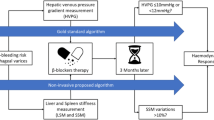Abstract
Background
Liver stiffness (LS) correlates with portal pressure (hepatic venous pressure gradient, HVPG). However, the dynamic components of portal hypertension (PHT) in advanced cirrhosis may not be adequately assessed by TE. The influence of treatment with non-selective β-blockers (NSBB) on the correlation of HVPG and LS has not been investigated.
Methods
One hundred and twenty-two patients with esophageal varices were included. LS, hemodynamic parameters, and HVPG were recorded at baseline (BL) and after 6 weeks of treatment with NSBB (FU). The correlation of LS and HVPG was compared to control patients with HVPG ≤ 12 mmHg.
Results
Patients with higher Child-Pugh stages (A:88/B:25/C:9) had higher levels of liver stiffness (47.4 ± 16.5 vs. 70.3 ± 7.9 vs. 73.7 ± 2.1 kPa) and HVPG (21 ± 5 vs. 26 ± 5 vs. 26 ± 4 mmHg). The correlation of LS and HVPG was stronger in controls with HVPG ≤ 12 mmHg (R = 0.951; P < 0.0001) than in patients with HVPG > 12 mmHg (R = 0.538; P = 0.0004). The association of HVPG with LS became stronger under treatment with NSBB, which finally restored the linear correlation of HVPG and LS (R = 0.930; P < 0.0001). Forty-three percent (53/122) of patients were hemodynamic responders to NSBB. The improvement in the correlation of LS and HVPG under NSBB was mainly noted in hemodynamic responders (R = 0.864), but not in nonresponders (R = 0.535), whereas changes in LS, heart rate, and MAP were similar in responders and nonresponders.
Conclusions
Targeting the hyperdynamic circulation and the increased splanchnic blood inflow by treatment with NSBB unmasks the linear (mechanical) correlation of HVPG and LS in patients with HVPG > 12 mmHg. Measurement of LS by TE is not a feasible method to assess the dynamic components of PHT.




Similar content being viewed by others
References
Bosch J, Garcia-Pagan JC. Complications of cirrhosis. I. Portal hypertension. J Hepatol. 2000;32(1 Suppl):141–56.
Iwakiri Y, Groszmann RJ. The hyperdynamic circulation of chronic liver diseases: from the patient to the molecule. Hepatology. 2006;43(2 Suppl 1):S121–31.
Gatta A, Bolognesi M, Merkel C. Vasoactive factors and hemodynamic mechanisms in the pathophysiology of portal hypertension in cirrhosis. Mol Aspects Med. 2008;29(1–2):119–29.
Blei AT, Mazhar S, Davidson CJ, Flamm SL, Abecassis M, Gheorghiade M. Hemodynamic evaluation before liver transplantation: insights into the portal hypertensive syndrome. J Clin Gastroenterol. 2007;41(Suppl 3):S323–9.
Garcia-Tsao G. Portal hypertension. Curr Opin Gastroenterol. 2004;20(3):254–63.
Bosch J, Abraldes JG, Berzigotti A, Garcia-Pagan JC. The clinical use of HVPG measurements in chronic liver disease. Nat Rev Gastroenterol Hepatol. 2009;6(10):573–82.
Garcia-Tsao G, Groszmann RJ, Fisher RL, Conn HO, Atterbury CE, Glickman M. Portal pressure, presence of gastroesophageal varices and variceal bleeding. Hepatology. 1985;5(3):419–24.
Abraldes JG, Tarantino I, Turnes J, Garcia-Pagan JC, Rodes J, Bosch J. Hemodynamic response to pharmacological treatment of portal hypertension and long-term prognosis of cirrhosis. Hepatology. 2003;37(4):902–8.
Merkel C, Bolognesi M, Sacerdoti D, et al. The hemodynamic response to medical treatment of portal hypertension as a predictor of clinical effectiveness in the primary prophylaxis of variceal bleeding in cirrhosis. Hepatology. 2000;32(5):930–4.
D’Amico G, Garcia-Pagan JC, Luca A, Bosch J. Hepatic vein pressure gradient reduction and prevention of variceal bleeding in cirrhosis: a systematic review. Gastroenterology. 2006;131(5):1611–24.
Castera L, Vergniol J, Foucher J, et al. Prospective comparison of transient elastography, Fibrotest, APRI, and liver biopsy for the assessment of fibrosis in chronic hepatitis C. Gastroenterology. 2005;128(2):343–50.
Foucher J, Chanteloup E, Vergniol J, et al. Diagnosis of cirrhosis by transient elastography (FibroScan): a prospective study. Gut. 2006;55(3):403–8.
Bureau C, Metivier S, Peron JM, et al. Transient elastography accurately predicts presence of significant portal hypertension in patients with chronic liver disease. Aliment Pharmacol Ther. 2008;27(12):1261–8.
Carrion JA, Navasa M, Bosch J, Bruguera M, Gilabert R, Forns X. Transient elastography for diagnosis of advanced fibrosis and portal hypertension in patients with hepatitis C recurrence after liver transplantation. Liver Transpl. 2006;12(12):1791–8.
Vizzutti F, Arena U, Romanelli RG, et al. Liver stiffness measurement predicts severe portal hypertension in patients with HCV-related cirrhosis. Hepatology. 2007;45(5):1290–7.
Sandrin L, Fourquet B, Hasquenoph JM, et al. Transient elastography: a new noninvasive method for assessment of hepatic fibrosis. Ultrasound Med Biol. 2003;29(12):1705–13.
Castera L, Foucher J, Bernard PH, et al. Pitfalls of liver stiffness measurement: a 5-year prospective study of 13, 369 examinations. Hepatology. 2010;51(3):828–35.
Lim JK, Groszmann RJ. Transient elastography for diagnosis of portal hypertension in liver cirrhosis: is there still a role for hepatic venous pressure gradient measurement? Hepatology. 2007;45(5):1087–90.
Peck-Radosavljevic M, Trauner M, Schreiber F. Austrian consensus on the definition and treatment of portal hypertension and its complications. Endoscopy. 2005;37(7):667–73.
Groszmann RJ, Wongcharatrawee S. The hepatic venous pressure gradient: anything worth doing should be done right. Hepatology. 2004;39(2):280–2.
Reiberger T, Rutter K, Ferlitsch A, et al. Portal pressure predicts outcome and safety of antiviral therapy in cirrhotic patients with hepatitis C virus infection. Clin Gastroenterol Hepatol. 2011;9(7):602–8.e1.
Millonig G, Friedrich S, Adolf S, et al. Liver stiffness is directly influenced by central venous pressure. J Hepatol. 2010;52(2):206–10.
Acknowledgments
This study was funded in part by an unrestricted grant of MSD Austria (former Aesca Pharma, Vienna, Austria) to Prof. Dr. Markus Peck-Radosavljevic.
Conflict of interest
None.
Author information
Authors and Affiliations
Consortia
Corresponding author
Rights and permissions
About this article
Cite this article
Reiberger, T., Ferlitsch, A., Payer, B.A. et al. Non-selective β-blockers improve the correlation of liver stiffness and portal pressure in advanced cirrhosis. J Gastroenterol 47, 561–568 (2012). https://doi.org/10.1007/s00535-011-0517-4
Received:
Accepted:
Published:
Issue Date:
DOI: https://doi.org/10.1007/s00535-011-0517-4




